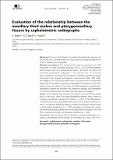Please use this identifier to cite or link to this item:
http://hdl.handle.net/11547/11380Full metadata record
| DC Field | Value | Language |
|---|---|---|
| dc.contributor.author | Sadry, S | - |
| dc.date.accessioned | 2024-03-21T11:15:44Z | - |
| dc.date.available | 2024-03-21T11:15:44Z | - |
| dc.date.issued | 2021 | - |
| dc.identifier.issn | 0015-5659 | - |
| dc.identifier.issn | 1644-3284 | - |
| dc.identifier.uri | http://hdl.handle.net/11547/11380 | - |
| dc.description.abstract | Background: The aim of this study is to evaluate the relationship between the third molars which are determined to be closely related to pterygomaxillary fissure (PTM) in cephalometric radiographs. Materials and methods: The material of this study was panoramic from 200 individuals (101 male, 99 female, mean age 19.02 +/- 1.62) with three different skeletal malocclusion in the sagittal direction (class I: 109; class II: 66; class III: 25) and lateral cephalometric radiographs. It was observed that 151 of the patients included in this study had unilateral, 49 bilateral impacted maxillary third molars teeth. Angular and millimetric measurements (SNA degrees, SNB degrees, ANB degrees, PTM [Height-x], PTM [Width-y]) were made in accordance with the parameters determined on the lateral cephalometric radiographs of individuals. In this retrospective study, the relation of impaction with PTM evaluated on cephalometric radiographs, whether the impaction was unilateral or bilateral, was investigated in terms of skeletal anomaly. Chi-square test was used for the analysis. Results: Of the 200 individuals with impacted maxillary third molar, 99 were female and 101 were male. There is no statistical difference between them in terms of unilateral and bilateral impacted third molars (p > 0.05). Of the 200 patients, 109 patients were class I, 66 patients were class II, and 25 patients were class III. There is no statistical difference between unilateral and bilateral impacted cases in facial skeletal classification (p > 0.05). According to chi-square test results, the relationship between genders and PTM variable width and height (PTM-x and PTM-y) measurements were not statistically significant (p > 0.05). Conclusions: The fact that the third molar teeth are impacted bilaterally or unilaterally is not affected by PTM change. | tr_TR |
| dc.language.iso | en | tr_TR |
| dc.relation.ispartofseries | 80;2 | - |
| dc.subject | TOMOGRAPHY | tr_TR |
| dc.subject | PREVALENCE | tr_TR |
| dc.title | Evaluation of the relationship between the maxillary third molars and pterygomaxillary fissure by cephalometric radiographs | tr_TR |
| dc.type | Article | tr_TR |
| Appears in Collections: | Web Of Science | |
Files in This Item:
| File | Description | Size | Format | |
|---|---|---|---|---|
| 69473-221089-2-PB.pdf | 298.9 kB | Adobe PDF |  View/Open |
Items in DSpace are protected by copyright, with all rights reserved, unless otherwise indicated.
